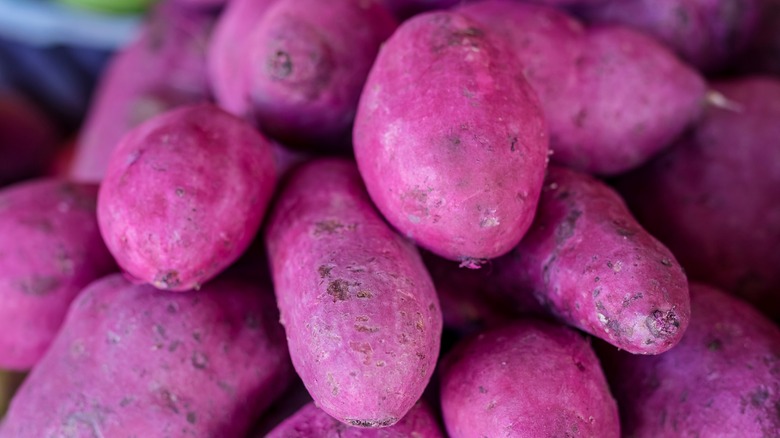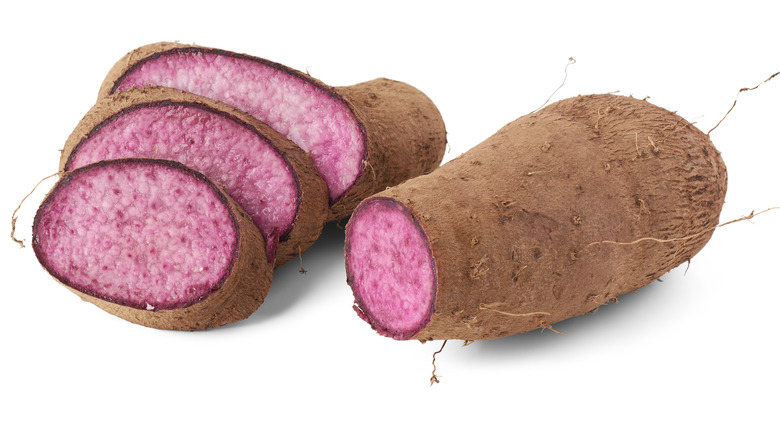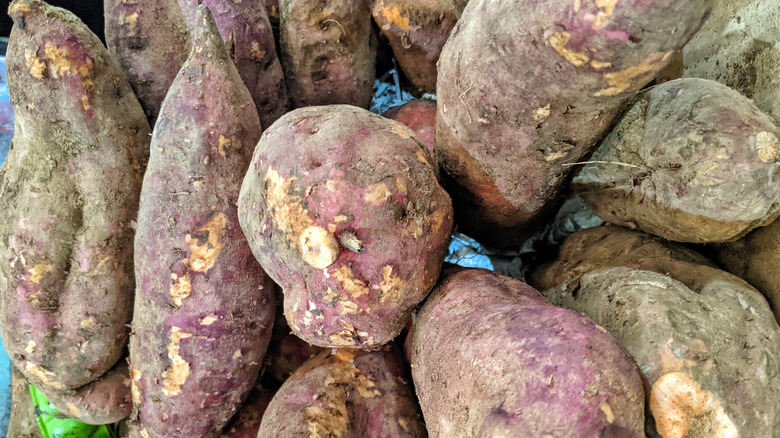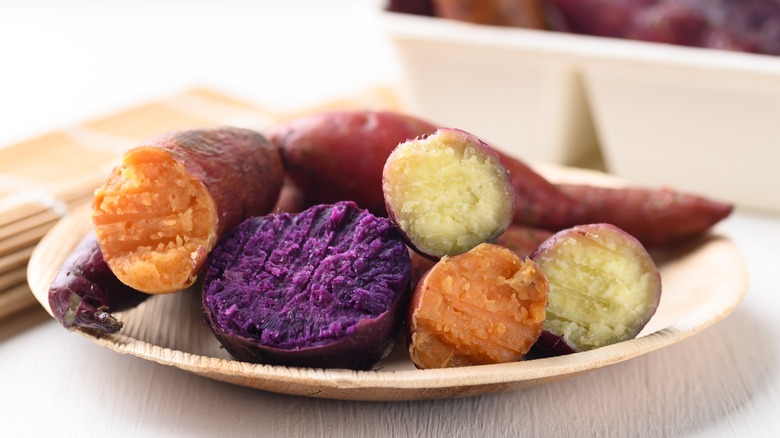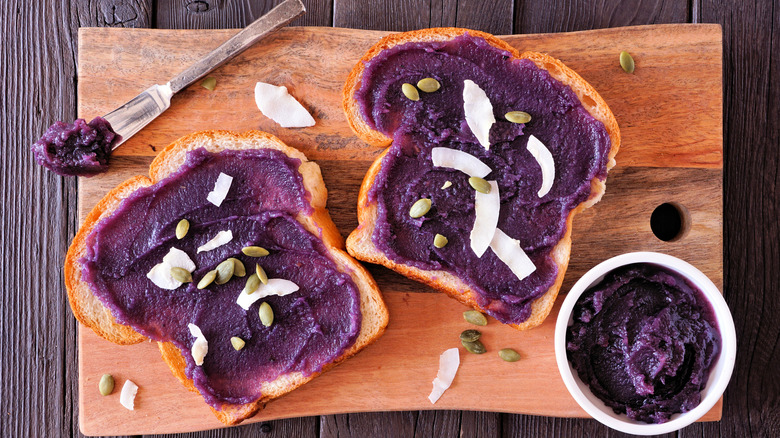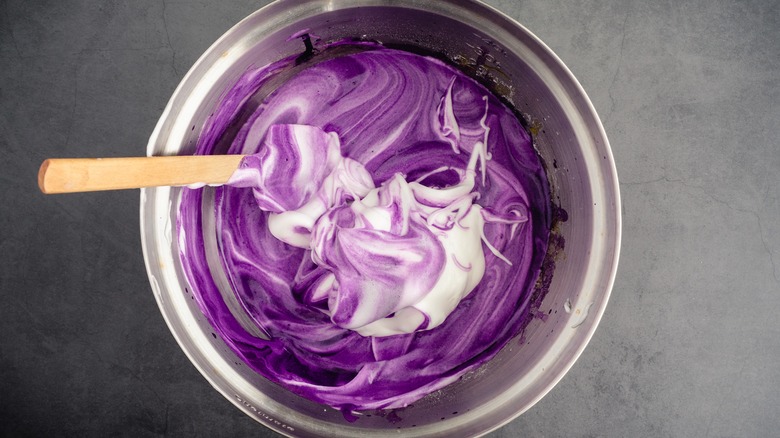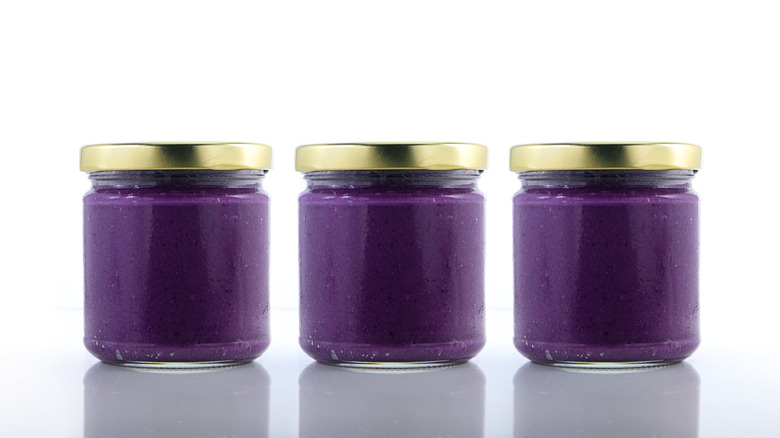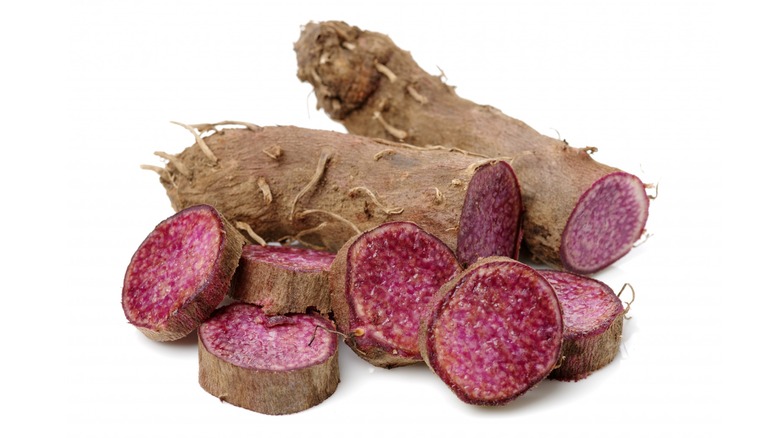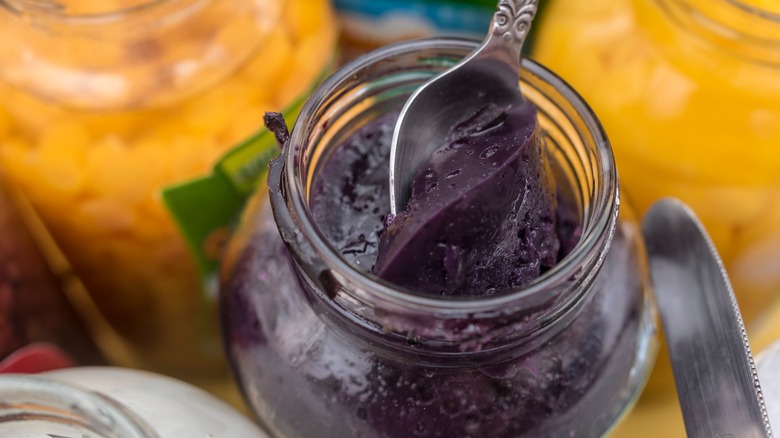Ube Is The Sweet Purple Tuber Perfect For Your Next Dessert
If you feel like lately you've been seeing purple desserts popping up at bakeries, purple lattes at your favorite coffee shops, and purple pancakes at Trader Joe's, it's not your imagination. Ube is the secret ingredient behind these purple-hued foods, and it's becoming increasingly popular in the United States, though it's been eaten in other parts world for as long as people have been farming. In fact, the New York Times even declared it the Tuber of the Year ahead of 2023 (expecting it to be an on-trend food for the year) backed by food processing company ADM's prediction for increased demand for purple foods in 2023.
But other than knowing that it's purple, what makes ube so special, and what does it taste like? This Southeast Asian tuber is also known as purple yam (not to be confused with purple sweet potato) and is widely used in Filipino cooking. In fact, it's been used culinarily for so long in Southeast Asia that it's considered to be a cultigen, meaning we don't have any record of it as a wild plant, only as one that's cultivated by humans for food, according to Epic Gardening. If you're interested in trying ube, here's everything you need to know about the trendy tuber, from what it tastes like to how to cook with it and where to buy some.
What is ube?
Ube or dioscorea alata is a type of yam, often called purple yam, due to the purple color of its flesh. Ube grows all over the Philippines in a number of different varieties prized for their varying colors, aromas, and flavors, according to Forbes, most ube in the Philippines is grown in the province of Bohol, and although the purple-hued tuber originates in Southeast Asia, CNN Philippines reports that today West Africa is the largest exporter of purple yam.
At first glance, ube might not look all that edible. The raw tuber has a thick, bark-like skin, and is usually covered with fine roots that have the appearance of thick wiry hairs. CNN Philippines described the tuber's appearance as "a shapeless, hardened piece of rock at its best." But that's just ube's outward appearance. Cut it open, and you'll see the brilliant purple flesh. Take a whiff, and might pick up aromas of vanilla, pandan, and pistachio.
Flavor-wise, ube has a natural, nutty sweetness, so it's most often cooked and used to make desserts and baked goods like ube halaya (ube jam) and ube pandesal (soft bread rolls made with ube). But it can also be used in savory recipes, especially ones in which you might regularly use sweet potato.
How is ube made?
Ube has been grown in the Philippines for centuries. It grows all over the region but is particularly fond of well-draining sandy soil and silty loam. Ube is the tuber of the yam plant, which is a twining vine that sports winged stems — this is the reason ube is also sometimes called "winged yam." To harvest ube, the tubers need to be dug up from underground.
The plants grow quickly, with the vines climbing up to 20–30 feet, and the tubers can grow to gigantic sizes — up to 8 feet says Epic Gardening — if not harvested. The tubers can be sold as-is, but they're often cooked and processed to create a variety of products from cooked mashed ube and grated ube that's sold frozen to ube powder and extracts for baking. It is often further processed to make commercially sold cookies, cakes, breads, and snacks.
Ube does need to be cooked. That's because, like potatoes, they contain toxins that are only neutralized after cooking. Most ube has small amounts of these toxins, but if you ever get an ube that tastes bitter, you shouldn't eat it, because the bitterness can be a sign that it contains a greater than normal amount of toxins.
The differences between ube, purple sweet potato, and taro
Once cooked, ube does bear a resemblance to the cooked flesh of purple sweet potatoes like Okinawan sweet potatoes and Stokes purple sweet potatoes. Taro, another root vegetable that has a white flesh with purple specks, can also present a lavender color that looks like ube when added to baked goods or drinks, like bubble tea. To add to the confusion, they are often used interchangeably when they are used to flavor products like bubble tea, lattes, or desserts. At times, they're even labeled incorrectly in grocery stores. But ube, purple sweet potatoes and taro are not the same plants, no matter how similar they might sometimes look.
There are a number of differences between purple sweet potatoes and ube. Firstly, although purple sweet potatoes are popular in parts of Asia, they hail from Central America. They are also part of the morning glory family, while ube is from Southeast Asia and is a true yam. These tubers have some textural differences once cooked, too — ube tends to be moister and firmer, while purple sweet potato is softer and dryer.
As for the differences between ube and taro, there are a few. For one, while ube is a true yam and a tuber, taro is actually a corm. It can have a light lavender color, especially smaller corms, but taro is usually white inside. It does have a slightly sweet flavor, especially the smaller purple corms, but in general, is not as vibrantly colored or as sweet as ube.
What does ube taste like?
The color of ube is certainly striking, but one of the main reasons it's so beloved is its flavor. Different varieties sport different flavor profiles, but in general, this tuber is known for having a sweet, nutty flavor, with notes of vanilla, pistachio, coconut, and pandan. And even though yams and sweet potatoes aren't the same thing, ube does have a similar earthy sweetness as that found in purple sweet potatoes.
The sweetest and most prized variety of ube is kinampay, which is often referred to as "the queen of Philippine yams" and is known for its complex flavor. And though the ube that seems to be so popular in America is dark purple and has those sweet, nutty, vanilla flavors, ube also comes in a variety of colors, including white, red, and pink and subtle flavor profile variations. If you want to add the taste of ube to a dessert, you can also use ube extract. For best results, use one that includes ube in the ingredients list, rather than artificial ube flavor.
How to cook with ube
Ube is always used once it's been cooked, as the raw tuber contains toxins. If you're using fresh ube, it needs to be peeled, then cooked (or cooked and then peeled, depending on your preference). It can be boiled, steamed, or baked, and then it's usually grated or mashed. The resulting paste or mash can then be incorporated into dishes. For home cooks looking to skip these steps, already processed ube is available in the form of powders, syrups, and premade jams and pastes.
In the Philippines, ube is usually added to desserts and baked goods. Popular favorites include ube halaya, a buttery ube jam that can be added to desserts or spread on toast; ube pandesal, fluffy purple bread rolls that have ube incorporated into the dough; and ube hopia, little desserts made with a flaky pastry that's stuffed with ube halaya.
But ube can be incorporated into many other dishes, too. Even though its texture differs from sweet potatoes, they're similar enough that ube can be swapped out for sweet potato in certain recipes, like sweet potato pie, mashed sweet potatoes, or sweet potato gnocchi. Ube can also be added to pancake and waffle batters to give them a purple color and nutty vanilla-like flavor. Trader Joe's, for example, has added ube to some of its seasonal baking mixes, mixed into ice creams and puddings, added to cakes and cookies, and more.
Where to buy ube
Fresh ube can be hard to find in the United States, but you might be able to get some at Filipino or Asian grocery stores. But in general, you're more likely to find products already made with ube (like store-bought ube halaya or ube pandesal), or cooked and processed ube that you can then use in your recipes. Check the freezer aisle at the Filipino or Asian grocery store for pre-cooked, mashed, or grated ube, and the baking aisle for powdered ube or ube extract.
You can also buy powdered ube, ube extract, and processed ube foods like ube flavored sweetened condensed milk online if you don't live in an area with a grocery store that carries it. Trader Joe's has a seasonal summer line-up of ube products, including ube spread and ube ice cream, if you want to try the flavor out. You may also be able to buy ube-containing foods from Filipino and other Southeast Asian or Pacific Islander restaurants in your area.
Nutritional information about ube
Ube may often be incorporated into desserts, but it's actually quite nutritious. According to Healthline, ube is a good source of nutrients like potassium and vitamin C, as well as energy-boosting carbohydrates. The purple color of ube comes from anthocyanins, which have been found to promote health in a number of ways, from reducing blood pressure and inflammation to potentially offering protection against type 2 diabetes and cancer. The flavonoids in ube can help lower blood sugar and reduce insulin resistance. Ube is also a low glycemic index carb, so the energy stored in it is broken down slowly in your system rather than all at once which can spike blood sugar.
Ube also has slightly higher quantities of fiber than purple sweet potato and regular sweet potato, containing 4 grams of fiber per 100-gram serving as compared with 3.3 grams. Fiber is nutritious for several reasons, from slowing the absorption of sugar into the bloodstream, helping digestion, and improving colon health, according to UCSF Benioff Children's Hospitals.
How to store ube
If you're lucky enough to find yourself with some fresh ube, it should be stored in similar conditions as other potatoes. Keep it in a cool, dark, dry place, but remember that raw ube, like sweet potatoes, shouldn't be stored in the fridge. Cooked ube should be placed in an airtight container or wrapped in plastic wrap, then stored in the fridge for up to three days, or in the freezer for up to a month. Store-bought frozen ube should be kept in the freezer until it needs to be used, and once opened, should be placed in an airtight container before being put back in the freezer (for instance, if you didn't use everything in the package).
Powdered ube should be stored the same way that you store other powdered ingredients: in an airtight container in a dark, dry spot that doesn't get sun exposure. As for jarred, store-bought ube halaya, or other ube-containing products, you should follow the storage instructions on the label. Ultimately though, these ube products are a great way to keep ube stored in your pantry or fridge for many months or longer particularly, if they're unopened, which is perfect for folks who might not live in an area where raw ube is widely available. If that's you, make a special trip to an Asian grocery store to stock up on a few ube products so you can enjoy ube's fantastic hue and beautifully sweet, nutty flavor in homemade desserts and drinks.
